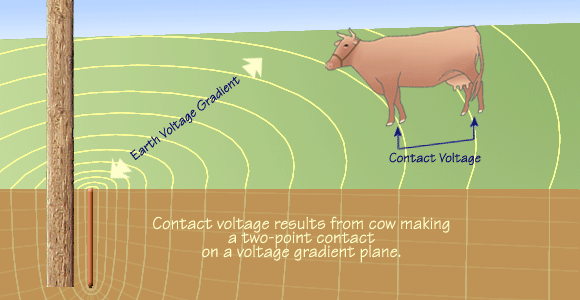 |
 |
 |
 |
 |
Animal Contact Voltages |
|
|
|
A dairy cow may be exposed to stray voltage in a number of different ways and at numerous locations, depending on the situation and facilities involved.
In all cases, the cow must make simultaneous contact between two points or structures on the surface of the earth in order to be exposed to stray voltage
[Gd Causes SV].
This is because animals, like people, do not "feel" electric voltages; what they feel is the resulting electric current flowing through their bodies. We have seen that for electric current to flow,
a closed-loop pathway is required,
which entails an entry and exit point on the cow's body; this is the two-point contact requirement mentioned earlier.
|

|
 
|
|
The stray voltage experienced by a cow in a given situation between two points is called contact voltage. Contact voltage is a manifestation of this stray voltage as it may be experienced by a cow at a specific location. The two terms are often used interchangeably.
|
|
A cow may experience a variety of contact voltages depending on which parts of its body are involved (right front foot to left, right rear foot to left, etc). However, determining contact voltage may be simplified by focusing on those situations that yield the highest contact voltage for the cow, i.e., the worst-case contact voltage for the animal. In most contact voltage situations, this consists of identifying and measuring the voltage between the longest of the typical distances that a cow can span.
|
|
The range of contact voltage experiences of a dairy cow may be reduced to two typical contact voltages: step voltage
[Step Voltage]
and touch voltage
[Touch Voltage].
Each of these cases is described in detail in the following pages. |
|
|





|
|
 |
|
 |
 |
|
